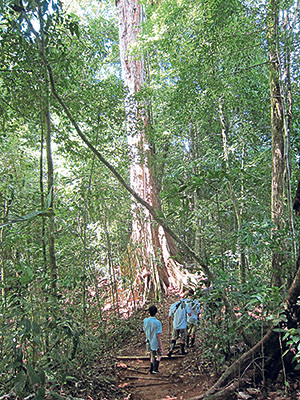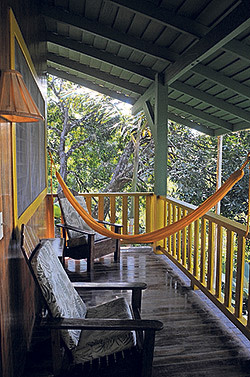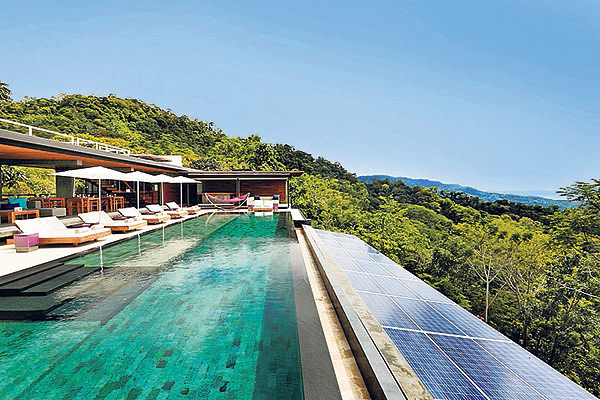Untamed Costa Rica

Simply sign up to the Life & Arts myFT Digest -- delivered directly to your inbox.
Slowly the tropics take us apart. The books are first to go, dissolving into the pulp they originally were, so you have to pick apart each page where it has melted into its neighbours. A recent magazine looks decades old. There’s the canopy always overhead, enclosing us in permanent dusk, and the constant danger of rotten boughs that fall without warning, of poisonous insects and lethal snakes. The dense warmth makes us short of breath, in spite of the air’s super-rich oxygen content.
The best thing is to get out of our cabin into the deep forest, where the air is a shade cooler, or to the beach, where the Pacific pounds and roars in a chorus that hasn’t interrupted itself in 3m years, not since the land of Central America rose from the waves. Rains come and go, thunderstorms flash, rumbling over the ridges behind. It’s not exactly the suburbs.
Yet I had heard that, compared with its troubled neighbours, Costa Rica was precisely that: suburban. It is often presented as domesticated, beloved of expats, Central America’s answer to Switzerland. As a result, I steered my family towards the least developed area, the southeastern end of the Pacific coast, in search of untouched rainforest and coastline lined with empty, wild beaches – beaches doing what they always did, before the tourism industry was invented and the word “beach” came to mean “holiday”. Here the strands are huge, broad, backed by receding lines of immense palm trees, and totally deserted. They are more daunting than inviting, formidable in their scale: oceanic, grand, with a few immemorial fishing canoes on log rollers drawn up on them. They’re an old kind of beach, more like the grey shore of Troy, places fit for an epic.
Behind them rise thousands of hectares of rainforest, coating the mountains in a deep blanket of greenery that contains a spectacular amount of life. About 5 per cent of the earth’s total biodiversity can be found in Costa Rica, scarcely bigger than the UK’s Home Counties. It is an intense place. Many roads are still dirt tracks, more or less passable according to the season, and many villages lie beyond the end of the tracks, accessible only by horse or foot. The wilderness is undaunted, unmolested. It’s not that the rainforest encroaches – more that to be here is a total immersion. There’s no being a visiting observer: you’re in it, and it takes over.
In 1998 Costa Rica passed the world’s first biodiversity law, protecting the wildlife and its habitats. Since the revolution of 1948, when José Figueres Ferrer abolished the army, this has been a visionary nation, steering itself towards a future different from that of most developing countries. As its UN ambassador declared in 2010, when the country won the Future Policy Award, “We are declaring peace with nature.”

Instead of the approaches to forests adopted elsewhere – lumber, mining if possible, then grazing cattle on the cleared land – Costa Rica has turned its attention to protection; as well as to ecolodges. They are everywhere. Some are basically a house with a spare room, others are high-end resorts in private estates.
Nature is the chief sales pitch of the ministry of tourism, and the purpose of ecolodges is, of course, to get you into nature. How much you are protected from it is the chief variable. We visited three, discovering just how wild this little haven of Latin America really is.
Tiskita Jungle Lodge is built behind a beach amid 800 acres of forest. This is one of the older lodges, dating back 40 years to when it was made into a homestead by Peter and Lisbeth Aspinall. He set up the farm as an exotic fruit orchard but his policy of not fertilising meant many of the varieties could not produce at a commercial level. So, at the request of family and friends the estate was turned into a “jungle lodge”. (We learnt much of this over the excellent meals served at a long table in the main lodge.) Up to 25 people can stay, in rustic cabins that blend into the environment, with decks offering views of the jungle and the pounding ocean surf below.
In Costa Rica there are a lot of animals. I’m not a good spotter; when I picked up the laminated lists of species in the lodge, I assumed I wouldn’t see any of them. But I did. On the first day. Here, to say certain animals are found doesn’t mean they’re out there somewhere; it means you will see them.
There are four species of local monkey; within two days we have seen them all. There is a red-eyed tree frog (delicate green with mauve flanks), a poison-dart tree frog, and Savage’s foam frog, close to a foot long – another day, and we’ve seen all of them too. There are toucans, scarlet macaws, many kinds of hawk, spectacled owls, diminutive bat falcons, giant blue morpho butterflies, and golden orb spiders, jumping spiders, wolf spiders – whatever there is, here you get to see it.

But we are every bit as much watched as watching. Squirrel monkeys with eager white faces stare at us from the leaves as we walk from our cabin to the lodge, their silky-brown fur dappled by the morning sun, before they leap away. Black iguanas study us from the side of the path, uncertain whether to advance or to retreat. A family of coati, foraging with their long bushy tails aloft like the masts of sailing boats, lift their striped snouts to gaze at us before hurrying up an earth bank and peering through the leaves as we walk by. A shaking of leaves announces capuchin monkeys that seem to want me to stare at them as intently as they do at me. Each time I look away, they shake the branches furiously.
We hike up to the estate’s 50ft waterfall, swim in the pool at its foot; we ride horses to a high ridge, passing a sloth gracefully transferring itself from one tree to another; we surf at a famous left-break near the sleepy village of Pavones; and swing in the hammocks on our jungle-shrouded deck, listening to the density of biodiversity.

The Golfo Dulce is a sleepy gulf 50 miles wide that cuts into the southeast coast near Panama. It is a breeding nursery for whales and hammerhead sharks, hemmed in by rainforest, empty of human traffic, a pre-Columbian wilderness of water and forest. We bump across its long swells in an open boat one morning, getting soaked by the warm water of the waves, with a silent man called Macho at the outboard.
On the far side is the Osa Peninsula, with Central America’s largest stand of primary lowland rainforest, much of it protected in the Corcovado National Park. Lapa Rios Ecolodge stands a few hundred yards back from the coast on high ground, with its own 1,000 acres of primary forest. Set up by a couple from Minnesota, it employs local people, with its own school and 16 palm-thatch bungalows strung along a ridge. It is everything one could hope for – the rooms broad and expansive, built of dark wood, in the thick of the jungle yet with views of the sea through strategic gaps in the trees.
The food is good and the feel is deluxe Swiss Family Robinson, with screens and mosquito nets offering reassuring protection. It keeps you sequestered from the jungle even while you’re in it. Its paths are groomed, its decks well swept. Knowledgable staff with walkie-talkies are everywhere, offering informative hikes every day. It feels tended, even a little manicured.
Nevertheless, you have to watch your step. On our first guided night walk we see two fer-de-lance snakes, coiled up, heads cocked, motionless in a torch-beam under a bush. The hunters of the forest aren’t as exciting as one might think. The bullfrog creeps into a hole all day and creeps out at dusk, only to sit still all night, occasionally zapping an insect with its adhesive tongue. And the snakes: they sleep coiled by day and by night they also lie coiled, still as if dead. It’s not the stealth of the big cats but the stealth of patience. Stillness is all.
There is one animal that is rarely seen. The jaguar is here but their numbers have been devastated, firstly because poachers hunt their staple food, wild boar; and secondly because starved of boar they go for cattle, which provokes farmers to shoot them.
We move westward along the Pacific coast to Kura Design Villas. Arriving here is surreal: a 3km bump up a mountainside, which may not sound like much but the road is awesomely steep and so appalling you feel every metre. It takes the best part of half an hour. Then a sheer cement wall appears, and equally sheer black steel gates. We enter a cubic world of grey cement and glass, worthy of a Bond villain’s hideaway, staffed by beautiful young people. What is this? Manhattan? Barcelona?
Beyond a slate-grey bar area and matching pool lounge, and beyond the horizon line of the infinity pool, the view hits you: a gulf of space, and below, far below, the long Pacific coast with the ocean roaring faintly.

With its piped music and minimalist design, Kura is like some trendy rooftop chill-out lounge, except it’s suspended over the rainforest. It is designed for couples: side-by-side loungers; suites with giant beds and huge windows; a chic dining area where chef Julio Mora delivers world-class food. The pool is like an art installation, with the colours of the sky reflecting off its pristine surface and a device producing the eerie effect of fire burning right on the water at night. This might not be the natural place for a birder, although binoculars abound in every room, still less for a boisterous family arriving grubby from the rainforest. But for honeymooners looking for a rainforest Olympus, it would be hard to beat.
Yet even here the forest intrudes, rising up behind in a green mountainside, falling away below in a spectacular arena of treetops. Insects appear, leaves fall, and sometimes clouds exhaled by the woods envelop the whole place and temporarily draw a veil across the view. Storms rumble through the valleys at night, then roll away muttering, to reveal the perfect view once more. We wake to wisps of cloud rising from the trees, and a gentle snoring of the ocean.
——————————————-
Details
Henry Shukman was a guest of Swiss Travel Costa Rica (swisstravelcr.com), which arranges packages throughout the country. He stayed at Tiskita Jungle Lodge (tiskita.com; three nights from $570 per person, with food and guided hikes), Lapa Rios Ecolodge (laparios.com; from $280 per person per night including food and guiding), Kura Design Villas (kuracostarica.com; villas for two from $460) and Xandari (xandari.com; doubles from $195), which is 7km from San Jose airport
Comments